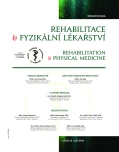Spasticity in Children Palsy
Authors:
P. Kolář
Authors‘ workplace:
Klinika rehabilitace a tělovýchovného lékařství 2. LF UK a FN Motol, Praha
Published in:
Rehabil. fyz. Lék., 22, 2015, No. 3, pp. 148-153.
Category:
Original Papers
Overview
Many types of cerebral palsy (CP) develop from spastic syndrome. Spastic syndrome presents with limited ability of selective movement, abnormal position of the extremities, disturbed muscle coordination, associated movements, clonus and stereotypical synergistic movement patterns. Spastic signs disturb specifically spontaneous movements of the infant (postural activity) as well as primitive reflexes and postural reactions. CP forms originally developing from spastic syndrome can further be categorized to several subtypes each presenting with different prognosis, different risk of contractures and joint deformities but also different response to the same therapeutic (conservative and surgical) procedures. Spasticity as well as any other type of muscle tonus disturbance typically affects movement patterns. Therefore, we consider movement pattern assessment to be much more appropriate type of clinical assessment then palpation. Physiotherapy procedures, prosthetic aids, medication including local botulinum toxin application and surgical procedures can be used to reduce spasticity. Highly skilled and experienced multi-disciplinary team is requited to treat spasticity and CP effectively.
Keywords:
spastic syndrome, postural activity, postural reactions, primitive reflexes
Sources
1. BOBATH, K.: A neurophysiological basis for the treatment of cerebral palsy. Cambridge, Cambridge University Press, 1980.
2. KOLÁŘ, P. a kol.:.Rehabilitace v klinické praxi. Praha, Galen, 2009, 713 stran. ISBN 978-80-7262-657-1 Koman LA, Mooney JF, Smith B, Goodman A, Mulvaney T. Management of spasticity in cerebral palsy with botulinum-A toxin: report of a preliminary, randomised, doublw-blind trial. J. Pediatr. Ortop., 1994; 14 : 299-303
3. KRAUS J., et al.: Dětská mozková obrna. Praha, Grada Publishing, 2005.
4. SCHEJBALOVÁ, A.: Moderní trendy v ortopedické terapii dětské mozkové obrny. Čes.-slov. Pediatr., 58, 2003, s. 578-585.
5. SCHEJBALOVÁ, A., TRČ, T.: Ortopedická operační terapie dětské mozkové obrny. Praha, Ortotika, s.r.o., 2008.
6. LIPPERTOVÁ-GRÜNEROVÁ, M.: Neurorehabilitace. Praha, Galén, 2005.
7. PEACOCK, W. J., STAUDT, L. A.: Functional outcomes following selective posterior rhizotomy in children with cerebral palsy. J. Neurosurg., 74, 1991, 3, s. 380-385.
8. PEACOCK, W. J., STAUDT, L. A.: Spasticity in cerebral palsy and the selective posterior rhizotomy procedure. J. Child Neurol., 5, 1990, 3, s. 179-185.
9. TROJAN, S. et al.: Fyziologie a léčebná rehabilitace motoriky člověka. 3. přepracované vydání. Praha, Grada Publishing, 2005.
10. VLACH, V.: Vybrané kapitoly kojenecké neurologie. Praha, Avicenum, 1979.
11. VOJTA, V.: Early diagnosis and therapy of cerebral disturbances of motility in infancy – reply. Zeitschrift für Orthopädie und ihre Grenzgebiete, 112, 1974, 2, s. 364-365.
12. VOJTA, V.: Mozkové hybné poruchy v kojeneckém věku. Praha,: Grada Publishing, 1993
Labels
Physiotherapist, university degree Rehabilitation Sports medicineArticle was published in
Rehabilitation & Physical Medicine

2015 Issue 3
Most read in this issue
- Spasticity in Children Palsy
- Shoulder in Epitome – Third Part
- Neuroplasticity, Restitution of Motor Function and Possible Rehabilitation Is Spastic Fibrosis
- Spasticity in Multiple Sclerosis
